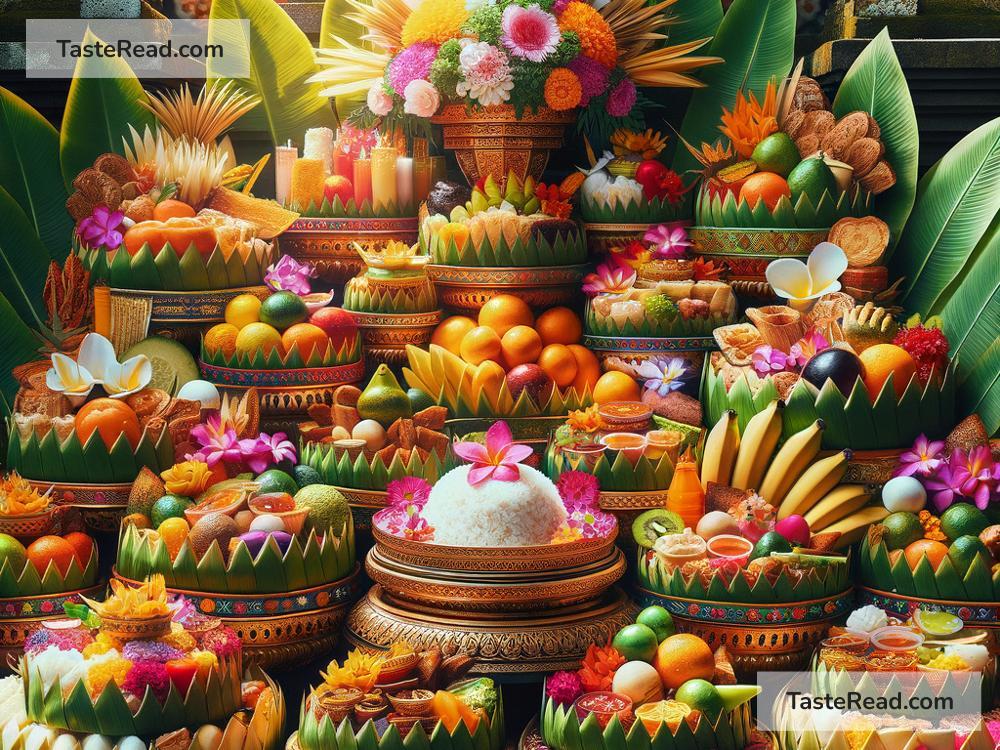Discovering Food Offerings at Balinese Hindu Temples
Bali, Indonesia, is a place filled with culture, tradition, and spirituality. A special part of Balinese Hindu practices is their use of food offerings, known locally as banten. These offerings are an important part of life in Bali, as they represent gratitude, devotion, and harmony with the universe. When visiting a Balinese Hindu temple, you will often see beautifully arranged food offerings placed on altars, shrines, or even on the ground. These offerings are not just about food but offer a glimpse into Bali’s spiritual and cultural essence.
What Are Food Offerings?
Food offerings, commonly part of the Hindu ritual ceremonies, are gifts given to gods, spirits, and ancestors as a sign of respect and gratitude. By making offerings, Balinese Hindus believe they maintain balance between humans and nature, between good and evil forces, and between different realms of existence.
The word banten refers to any ceremonial offering, but in most cases, food offerings take center stage. These can include flowers, rice, fruits, cakes, and other colorful items neatly arranged in a small basket made from palm leaves or other natural materials.
These offerings are not meant for people to eat. They are symbols of giving and represent the sharing of blessings. Only after certain ceremonies may people consume some of the offerings, but this happens depending on particular rituals or traditions.
What Food is Used in Offerings?
The food in Balinese Hindu offerings is both symbolic and practical. Every item has its own meaning and purpose. Here’s a closer look at some of the common foods used in temple offerings:
-
Rice
Rice is a staple in Bali and is considered sacred. It is seen as a symbol of life and prosperity. Small portions of cooked white rice are often placed in the center of the offering. -
Fruits
Bright, fresh tropical fruits like bananas, oranges, mangoes, apples, or coconuts are frequently used. Fruits symbolize abundance and the beauty of nature’s gifts. -
Traditional Cakes
Colorful, sweet cakes made with rice flour, coconut, and palm sugar are chosen for their variety and texture. Often, you’ll see small cakes called kue or jaja Bali. Cakes bring a cheerful feeling to the offering and represent joy. -
Betel Leaves and Areca Nuts
These are traditional items found in many offerings, representing gratitude and respect for ancestors. -
Other Snacks
Some offerings include crackers, candies, or packaged snacks. While these might seem modern, they reflect practicality and the everyday nature of food in Bali. -
Decorative Items
Alongside food, offerings may also include colorful flowers, incense, and coconut leaves crafted into beautiful designs. These decorations enhance the visual appeal and bring spiritual energy to the offering.
How Are Food Offerings Made?
Creating food offerings is an art and a spiritual practice. Often, women in Bali prepare the offerings early in the morning or the day before ceremonies. The process isn’t rushed—it’s done with care and devotion.
They weave small baskets and trays from coconut or banana leaves to hold the food. Each item is carefully placed in its specific spot. The arrangement might vary depending on the temple or the occasion, but the attention to detail is universal.
After preparing the offerings, they are brought to the temple as part of a larger ritual. Priests bless the offerings using holy water and prayers, allowing them to fulfill their spiritual purpose.
When Are Food Offerings Given?
Food offerings are given during many different occasions in Bali, such as:
- Daily Rituals: Balinese Hindus make small offerings every day at their home temples or street-side shrines. These are smaller versions of the ceremonial offerings seen during major events.
- Monthly Ceremonies: On certain days marked by the Balinese calendar, larger offerings are prepared for celebrations in homes and temples.
- Festivals: Special occasions like Galungan, Kuningan, and Nyepi involve grand ceremonies with elaborate food offerings and decorations.
- Temple Celebrations: When a temple has its anniversary (odalan), local communities gather to prepare offerings that are often more intricate and impressive than everyday ones.
What Happens to the Food Offerings?
After the offerings have been blessed, they fulfill their spiritual purpose and are considered sacred. Some are left at the temple to allow nature or animals like birds to take them, signifying harmony with the environment. In other instances, parts of the offerings may be taken back home or redistributed among families as symbols of blessings.
Respecting Offerings As a Visitor
If you’re visiting Bali and exploring its beautiful temples, take a moment to appreciate the offerings you see. Remember to treat them with respect, as they hold deep spiritual meaning for the Balinese people. Avoid stepping on them if they are placed on the ground or interfering with their arrangement.
Conclusion
Food offerings in Balinese Hindu temples are more than just colorful baskets of rice and fruits—they are a reflection of Bali’s values of gratitude, balance, and spirituality. These offerings show how tied together food, art, and religion are in Balinese culture.
Whether you are in Bali to experience its temples or learn about its traditions, noticing and understanding these food offerings can help you gain a deeper appreciation for how the people of Bali live in harmony with the world around them. Why not take a moment to enjoy the beauty and meaning behind this sacred practice?


